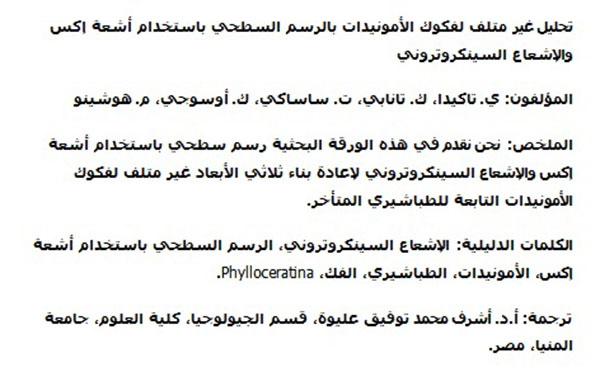Non-destructive analysis of in situ ammonoid jaws by synchrotron radiation X-ray micro-computed tomography
Virtually all modern cephalopod mollusks possess a well-developed jaw, consisting of upper and lower elements, and a radula as their primary feeding organs. These structures are housed in a muscular organ called the buccal mass within the digestive tract and allow the mollusk to bite and shear their prey. Fossilized remains of jaws and radulae are occasionally preserved within the body chambers of ammonoid conchs, but complete excavation of them is difficult as typically they are embedded in a consolidated sedimentary matrix. This study introduces for the first time a three-dimensional (3D) reconstruction of the jaw of the Late Cretaceous phylloceratid ammonoid, Phyllopachyceras ezoensis, created using high-resolution synchrotron radiation X-ray tomography. Our analysis suggests that both the upper and lower jaws of the species were originally made of a chitin-protein complex similar to that of modern cephalopods, but their outer surfaces are wholly covered by a calcareous material. The overall jaw architecture resembles that of other Mesozoic ammonoids, except for the development of a calcareous covering on both the upper and lower jaws, which appears to reflect the predatory-scavenging feeding habits of the species. This and previous work suggest that the overall morphology and composition of the jaw in Mesozoic Ammonoidea have been developed under genetic and functional factors.
Resumen en Español
Análisis no destructivo de mandíbulas de ammonoideos in situ por microtomografía computarizada de rayos-X con radiación de sincrotrón
Presentamos la tomografía de rayos X de alta resolución con radiación de sincrotrón para la reconstrucción tridimensional no destructiva del aparato mandibular preservado en la cámara que alberga el cuerpo del ammonoideo Phylloceratidae del Cretácico Tardío Phyllopachyceras ezoensis. El análisis de las imágenes de rayos X usando la estimación del coeficiente de absorción lineal revela que la mandíbula superior consiste principalmente de láminas internas y externas compuestas de carbonato apatito, que originalmente pudo haber sido un complejo de quitina-proteína, con bordes angulosos de material calcítico grueso. Las características morfológicas indican que el aparato mandibular de esta especie es del tipo rhynchaptychus. La arquitectura tridimensional del aparato mandibular de estos especímenes es similar a la de otros ammonoideos, excepto por el desarrollo de un grueso depósito calcificado tanto en la mandíbula superior como en la inferior, lo que puede ser considerado como una evidencia de hábitos alimenticios depredadores para la especie. Las características de la mandíbula de esta especie parecen haber tenido constricciones de factores filogenéticos y morfofuncionales.
Palabras clave: radiación de sincrotrón; tomografía computarizada de rayos X; Ammonoidea; Cretácico; aparato mandibular; Phylloceratina
Traducción: Enrique Peñalver (Sociedad Española de Paleontología)
Résumé en Français
text
Translator: Kenny J. Travouillon or Antoine Souron
Deutsche Zusammenfassung
Zerstörungsfreie Untersuchung von in situ Ammonitenkiefern mit Synchotron Mikrocomuptertompgrafie
Wir präsentieren erstmals hochauflösende Synchotron-Röntgentomografie für eine zerstörungsfreie, dreidimensionale Rekonstruktion des Kieferapparates - erhalten innerhalb der Wohnkammer - des spätkretazischen phylloceratiden Ammonoiden Phyllopachyceras ezoensis. Untersuchungen der Röntgenbilder mit einem linearen Absorptionskoeffizienten zeigen, dass der Oberkiefer hauptsächlich aus inneren und äußeren Lamellen aus Karbonat-Apatit besteht, der möglicherweise ursprünglich ein Chitin-Protein Komplex mit abgewinkelten Rändern aus dickem kalzitischem Material war. Die morphologischen Merkmale weisen darauf hin, dass der Kieferapparat dieser Art vom Rhynchaptychus-Typ war. Die dreidimensionale Architektur des Kieferapparats dieser Stücke gleicht dem anderer Ammonoiden, bis auf eine dicke kalzifizierte Ablagerung in Ober-und Unterkiefer, die wahrscheinlich die räuberisch-aasfresserischen Fressgewohnheiten dieser Art unterstützten. Die Kiefermerkmale dieser Art scheinen sowohl durch phylogenetische als auch funktional-morphologische Faktoren begrenzt zu sein.
Schlüsselwörter: Synchotronstrahlung; Röntgencomputertomografie; Ammonoidea; Kreide; Kieferapparat; Phylloceratina
Translator: Eva Gebauer
Arabic

Translator: Ashraf M.T. Elewa

